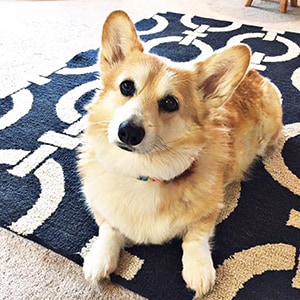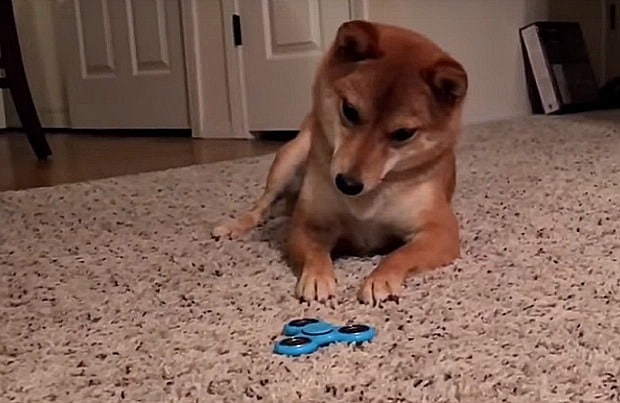The pot roast sat in a bowl on our kitchen floor, cold and untouched.
The same thing happened with the slab of turkey, along with ground hamburger meat and even the holy grail—warm, crispy bacon.
We had never known our Corgi to refuse a meal, or a stray crumb for that matter. So when Ginger stopped eating, it was a lot like watching a dolphin suddenly refuse to swim or a cheetah that no longer ran. She’s marked by her insatiable appetite for life and dog food in equal parts, so her disinterest was worrisome to say the least.
It began last fall. Ginger was having accidents and wasn’t running to the door to greet us when we came home. In fact, she could barely lift her head to look at us.
After two days of these strange symptoms, we brought her to our veterinarian. A urinary tract infection? No. Something wrong with her kidneys? No. After several tests, we finally determined that her “liver had taken a hit,” in the words of our vet, but it was a mystery as to what was making her feel so terrible.
After a solid month of testing, which included a liver biopsy, the answer appeared. Ginger had copper storage disease, an incredibly rare genetic disorder in dogs that is common in some breeds but hardly ever seen among Corgis.

Our vet was cautiously optimistic, but our many appointments and phone conversations couldn’t help but be tinged with that underlying thought of “is she going to make it?”
I didn’t want to think it, but I did. Her liver blood tests were through the roof. She had hepatitis. And to make matters worse, she had stopped eating completely.
My husband and I don’t have children. Ginger and her kitty sister Coco are our kids. He and I opted for the “aggressive” treatment plan, taking her to the local university for highly-specialized care. “This is where all of the copper storage dogs come,” we were told.
The treatment plan was a daunting one: several rounds of therapy to remove the metal from her liver, liver-boosting meds, a prescription diet and, the most challenging part of all, a feeding tube, something we finally resorted to after there were too many uneaten bowls of food.
The first few days were downright scary. We fed her liquefied dog food through her tube as gently as we possibly could, but couldn’t help but think, “what if we hurt her? What if her tube comes out? What if we do all of this and it doesn’t work?” What if, what if, what if.
Then, magically, we found a groove. The endless hours of administering meds and feeding her through the tube turned into a manageable hour or two per day. Very slowly, we watched our dog come back to us.
I’ll never forget those firsts—the first time she met us at the door again. The first time she picked up a toy again. And the greatest first of all, when she found a piece of stray kibble on the floor and ate it on her own. We had friends at the house at the time, and we took a video and started cheering when she ate the additional kibble pieces we tossed to her.

The tests also proved that our hard work was paying off. Her numbers had improved dramatically in only a few short months. My husband and I were exhausted, and worry still loomed over us, but we began to have hope.
In July, Ginger’s feeding tube site developed an infection, despite our best efforts to keep it clean. “Her body is rejecting it,” our vet told us. So, out it came. At that point, she had begun to start eating here and there, and we knew we had to pull out all the stops to get her to eat. We turned mealtime into a game, tossing pieces of food in the air so she could catch them. This process was fun for her, but for us, it took even longer than feeding her through a tube. But we maintained our patience. We were so closeto having a healthy dog again.
The site continued to get infected. After several rounds of antibiotics and a dog that was clearly lethargic, we decided to have a vet check it out. They discovered a hole in her esophagus, which was a possibility since the feeding tube had been in for a lengthy eight months. She had another liver biopsy at the same time, bringing the tally of surgeries to five in the space of a year.
That biopsy brought us good news—her liver numbers were manageable, and she had made an astounding recovery. The vets told us we could now be in “maintenance mode,” meaning just a few pills a day and continuing with her prescription food.
Today, over a year later, we have our vibrant, vivacious little dog back. She gobbles down her food, she spends her time looking out the window and barking. She even interrupted my writing by gleefully resting a toy at my feet. This is a transformed dog.

Our experience called upon me to discover new reserves of strength I didn’t know I had. When we were in the throes of Ginger’s disease, it was winter, and I was deep in the caverns of seasonal affective disorder. I was forced to fight through my depressive state and put my love and energy into caring for her.
I’m usually squeamish, but I handled freshly-inserted feeding tubes, blood draws and the pungent smell of infection without batting an eye. And I rarely cried, something I usually do at the drop of a hat.
There’s a special kind of strength that can be discovered when you’re caring for a living, breathing creature. Although our little family experienced something I wouldn’t wish on any dog lover, it awakened a mental toughness in me that I’ll continue to carry with me for the rest of my life.
And for that, Ginger, I thank you.

Shelby Deering is a lifestyle writer and dog lover from Madison, Wisconsin. When she’s not writing for national magazines and websites that include Midwest Living, Rodale’s Organic Life and The Spruce, she’s snuggling up to her dog and cat or asking to pet every dog she sees.
Share:









